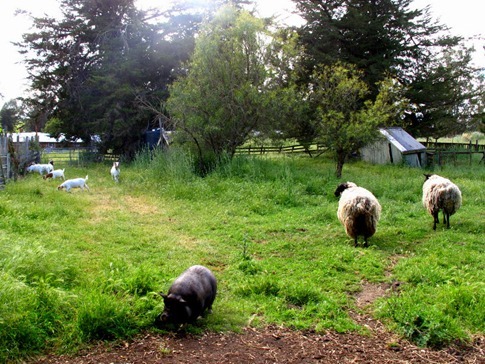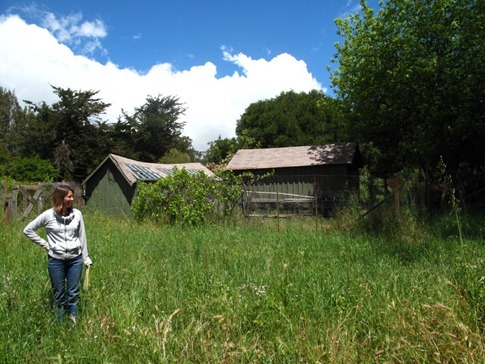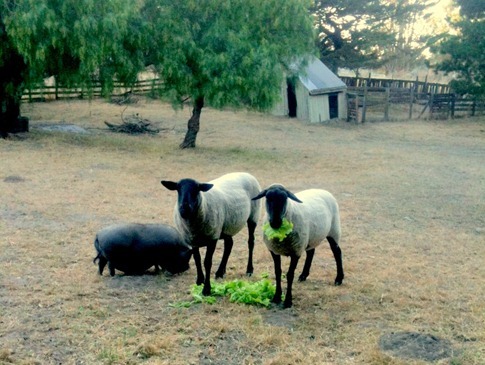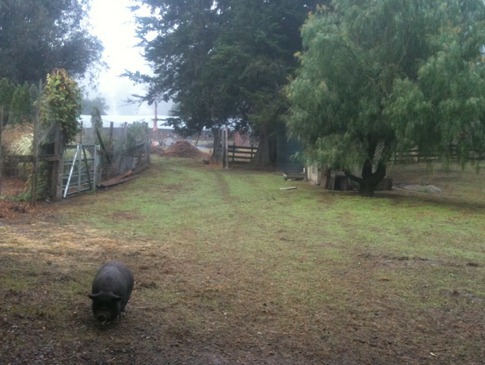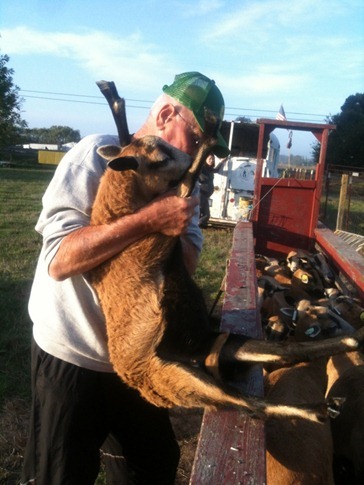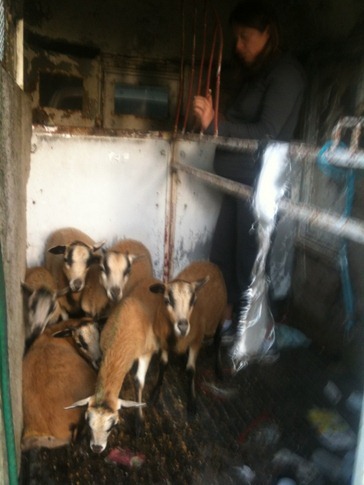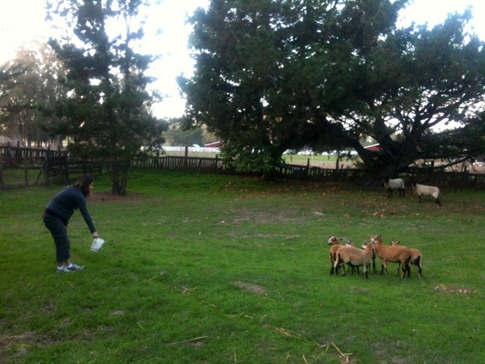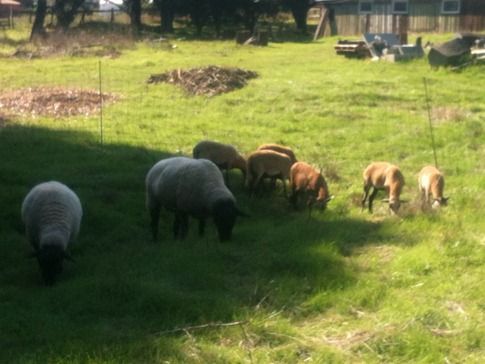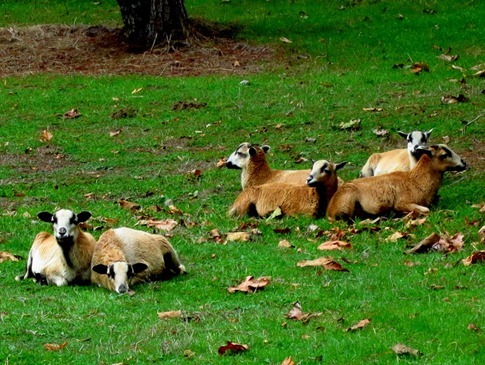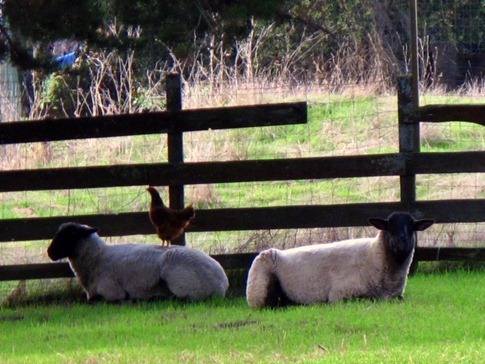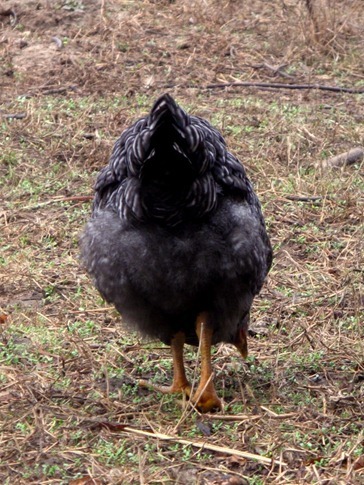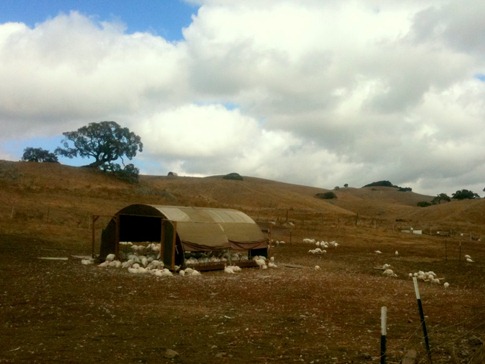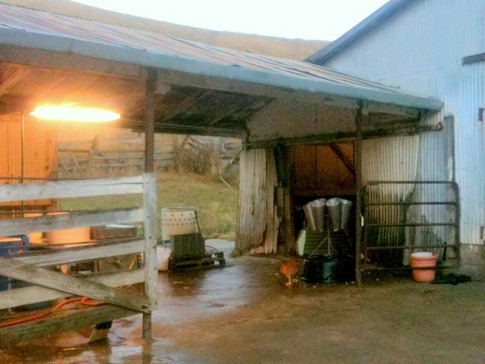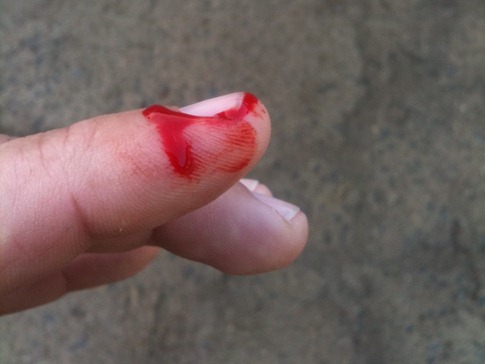When we first looked at this property in April, there were areas we didn’t even set foot on because the grass was too high and filled with thistles. I spent hours trying to rationalize buying a tractor and ended up settling on an ATV with a heavy duty tow-behind mower to keep the weeds at bay. To assist the pig and two ridiculously over-dressed sheep that already lived there, we arranged to “rent” 9 goats to munch on the waist high grass.
Since around the middle of June, the fields here have been brown, scorched by the warm, dry summers of Sonoma County. The sheep were sheared of the overbearing fleece they’d accumulated over the past couple years, and we’ve had to supplement their diet with alfalfa and some treats from the garden.
But the other day, I walked out to the pasture gate and something strange caught my eye: the color green. It was the first sprouts of grass, brought to life by a few days or rain earlier in the week.
Immediately, I felt a panic, like I’d just seen an invading army amassing for an attack. It’s coming! The grass is coming!!! I got on CraigsList and opened up the North Bay Farm & Garden section looking for anything with a rumen. In the past months, browsing these listings has become almost a voyeuristic guilty pleasure, a way to learn about the natural cycles of country living, when the 4H kids sell off their prize winning specimens and who’s wife is making them thin their herd of tractors rusting out by the barn.
We’d enjoyed having the goats in the spring but found them to be a little mischievous, searching for holes in the fence and ways to get into everything, and decided sheep might be a better way to go. And despite a few delicious successes with ground goat meat in our Marin Sun Farms meat CSA box, we still felt irrationally more comfortable with the idea of raising sheep for meat. The two sheep we had are Suffolks, known for their large size and good eating - said to the be only lamb the Emperor of Japan will serve his guests – but the wool is short and dense with some black fibers that make it less popular for spinning. I found a listing for a flock dispersal, someone looking to unload all his Suffolk sheep - 5 or 6 including a ram – which was tempting, but we were interested in learning more about hair sheep, breeds developed with a coat more like that of a goat that wouldn’t need shearing.
The most popular breeds of hair sheep in the US seem to be Dorper, Katahdin, and Barbados and American Blackbellies. All three are said to be easy to keep (because they don’t need their tails docked or to be sheared), resistant to parasites, attentive mothers (important as this trait has been selected out of other breeds), and, of course, delicious with a rich but not “muttony” meat. In the midst of web searches for breeder directories and deliberations between the merits of each breed, Ann arrived home one day and mentioned that she’d seen some really cute reddish brown “goats” with black on the their stomachs in a pasture just up the road. We drove by the next time we were out, and for the first time noticed the large yellow banner hanging on the fence in front of them that read “Barbados Blackbelly Sheep.” A week or so later, we met with Ed from Jingle Farm to pick up our new yard crew (technically they were “American Blackbellies”).
Ed loaned us a beat up old horse trailer with one mostly flat tire to get them home. Fortunately, we only had to go about half a mile. Still, we must have looked at each other about 20 times to say, “We just bought sheep” and laugh at the direction our lives had taken.
After a few minutes skeptical of their new surroundings, they fell into step behind the big sheep. Whereas previously we’d see the more outgoing female sheep parading around the pasture with the male sheep shadowing her – we call them Sheeple Dee and Sheeple Dum - now they were both trailed by a caboose of 6 tiny brown lambs, always packed shoulder-to-shoulder in a tight unit.
The Landscaper’s Union rules mandate a 15 minute break every 4 hours.
Okay, it’s possible that the Suffolk sheep have gone a little soft. The chickens are literally walking all over them.
And anyone with a handful of sweet feed is their new best friend.
Oh, and guess what?
Yes, chicken butt. Zing.
Since moving to Petaluma, we’d been hearing a lot about Tara Firma Farms and seeing their name at the farmer’s market. They also offer free farm tours on the weekends, so we stopped by one afternoon to have a look around. Once we get interested in something, we tend to devour all the books, web sites, speakers, events, etc having to do with it in pretty short order. And from the tour at Tara Firma, it was clear that we’d read enough Michael Palin (Omnivore’s Dilemma) and Joel Salatin (Polyface Farms) to understand the approach to pasture management, grass fed beef, poultry rotation and organic farming they were practicing on this hundred-plus-acre former dairy farm.
Turkey poults gaining strength and feathers before they can roam the pastures. We put a deposit down on two turkeys for a Thanksgiving party in a month or so.
I ran into Tara behind the farm store where she explained that she’d been shifting the operations to allow herself to spend more time out with the animals rather than stuck in the office. While their scale is much larger and the goals different than ours – public consumption rather than personal supply – it seems like everyone in this local food, permaculture, homesteading community is happy to share information. I agreed to look into some designs for automatic chicken coop doors and report back to her on our new sheep flock in exchange for her wisdom on pastured pigs and turkey poults. When I mentioned our interest in having meat chickens at some point, she invited me down to watch them process chickens early on Tuesday mornings.
[WARNING: The next section acknowledges the necessity of chicken to be killed before it can be eaten whether in breast, thigh, leg or McNugget form.)
Curious about how the process would affect me but resigned to face the realities of meat consumption, I woke up at 6:30 am a few Tuesday’s later and drove the 15 minutes out to Tara Firma farms in the dark. There, I found Corey (who had been our tour guide) and his rowdy crew of three dressed in high rubber boats and vinyl aprons. Though it was a “light day,” only 180-200 chickens to be processed, each man knew his role and quickly prepared his station. Corey would grab two (sometimes three!) white chickens with wings flapping madly from a holding pen and flip them head down into one of 10 metal cones on a rotating stand. They must not have know what these were called – “killing cones” – because as soon as they felt the pressure of the narrowing metal, they became calm and let their heads poke through the hole at the bottom. Corey explained that even a sharp knife wouldn’t cut through the feathers on the neck and demonstrated how to angle the blade down between the quills. With a quick slice of the carotid artery just below the jaw bone, a steady stream of blood would flow in the catch basin below. While it seemed clear from the eyes that life had left the bird immediately, the nervous system extended the legs and twitched the bodies around for 10-20 seconds before they fell silent.
I was strangely comforted by the lone Rhode Island Red (seen above) wandering around the killing cones, picking at bits of blood and feathers. It was clear that other than some necessary stress from being picked up, the chickens were completely unaware of what was happening to them. The buzzword lately in the raising and slaughtering of animals for meat is “humane.” It’s a tricky thing; How do you “humanely” kill something? For me, the answer lies in the treatment and lifestyle of the animal – an animal that would not have existed were it not for our intention to use it to sustain ourselves – from its birth through its death. In its ability to do the things and live in the type of environment it’s evolved for. In expressing its unique characteristics and capabilities, whether of the sheep and cow to convert grass into meat or the pig to root and till land or the chicken to harvest control parasites by eating larvae in manure. To paraphrase Michael Pollan, “A great life leading up to one bad day.”
I’ve seen statistics that 14% of all greenhouse gases come from livestock, methane in particular from cows. And contrary to what you’re thinking, apparently most of it comes out of their mouths, not the other end. And perhaps interesting to those of us in favor of a natural grass-only diet for our meat, pastured cows emit even more methane than those in CAFO’s (Concentrated Animal Feeding Operations) that pump them full of grain and other byproducts their rumens are not designed to handle. But in the end, it’s a question of quantity, a need for quantity that has led to a sharp decline in quality, both of the meat and the lives of the animals we raise for it.
Ann and I are in the process of taking something of an inventory of our consumption and becoming more connected to the production that feeds us. The other night over a chicken sandwich at a local burger joint, we tried to estimate how many chickens we are typically indirectly responsible for killing each year. Note, we used to eat a lot of chicken, considering it the “healthier choice,” but since Ann developed an aversion to it during pregnancy and we signed up for a Marin Sun Farms meat CSA, we’ve only eaten it a few times since we’ve been back in the US) Typically, my go-to meal when it was my turn to cook dinner was always chicken breasts, rice and broccoli. In fact, maybe once a month, I’d BBQ up 6 full chicken breasts so we’d have them in the fridge for lunches. Let’s say we get “credit” for the rest of the chickens accounting for several meals spread out over the month in the form of hot wings to go with a beer, shredded chicken in tortilla soup or chopped chicken in a burrito. Not even counting the occasional rotisserie chicken from Whole Foods or chicken sandwich out at a bar, that’s 6 chickens a month. Seems like a lot all of a sudden doesn’t it? That’s 72 a year for the two of us!
As soon as we started to put that in the context of what would be involved in raising them ourselves our thinking immediately shifted; Instead of thinking about how delicious chicken burritos are, we thought about how many chickens it might seem reasonable for us to “take” for our own nutrition. What’s your number? We settled on feeling okay about 2-3 chickens for the two of us, maybe roast one on a Sunday and eat leftovers that week, BBQ another mid month and maybe break another one down for chicken soup or fajitas. There, we cut our chicken consumption by more than half (and 24 a year still seems like a lot!). Maybe the grass fed, pasture raised, “humane” model of meat production would seem a little more viable and appealing if everyone took a similar look at their food.
From the killing cones, the chickens went into a scalding bath and then a spinning plastic bin with rubber fingers that grabbed the feathers loosen by the hot water. On a clean plastic folding table, another worker removed the heads and feet and with a delicate incision around the anus, freed the innards of the bird in one unit. There on the table, maybe 5 minutes from when it first tried to flap free of Corey’s grasp, was a chicken that looked like something you’d see in a grocery store.
After watching the whole process and gathering my resolve – of course, I was conflicted and in some ways, that made me feel better about it – and accepted Corey’s offer to let me “harvest” a few. I did as I had been instructed and like the others, the blood drained and the bird twitched. I moved to the next one, this time more confident that I had could make the cut precisely and thus without stress to the bird. After a deliberate and effective draw along the neck of the third, I felt a burning and throbbing from the finger that had been holding the back of the neck through the bottom of the cone. I’d nicked myself pretty good. While Corey and his crew would be killing a couple hundred chickens that morning to feed the Tara Firma CSA customers, three was enough for me. I’d done my work for this month and had felt the sharp end of our meat consumption.

